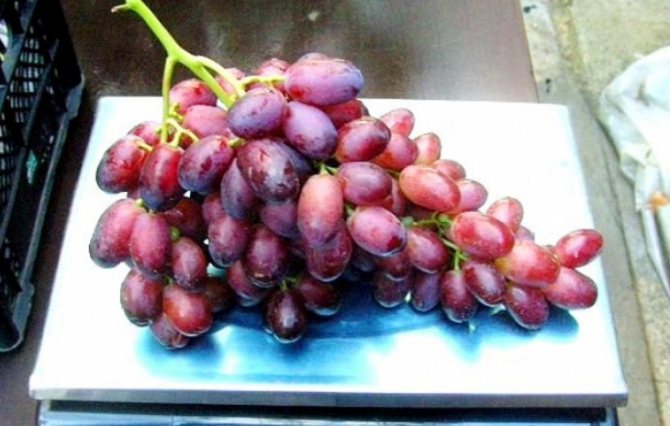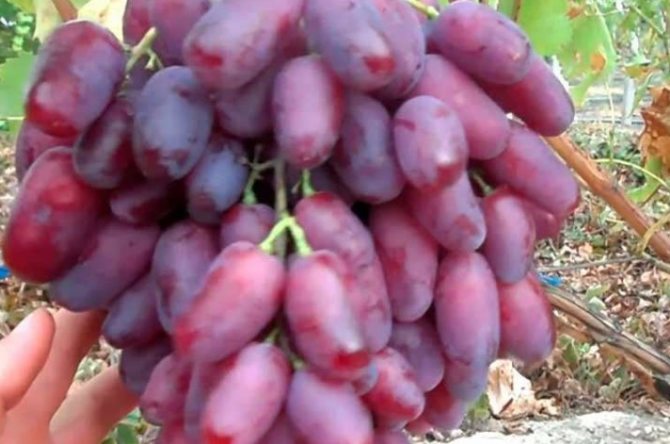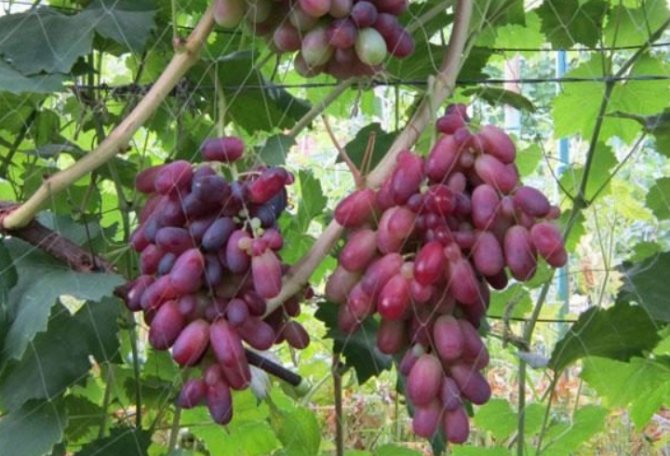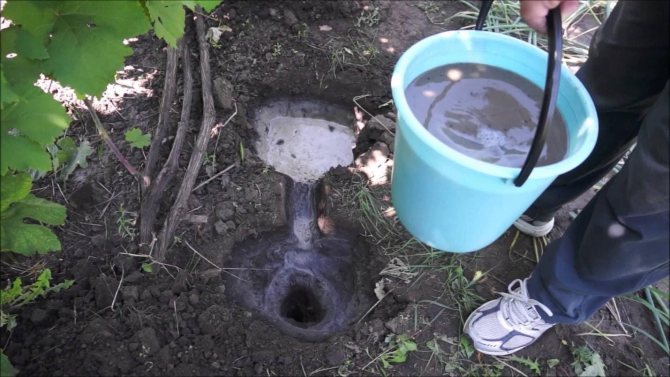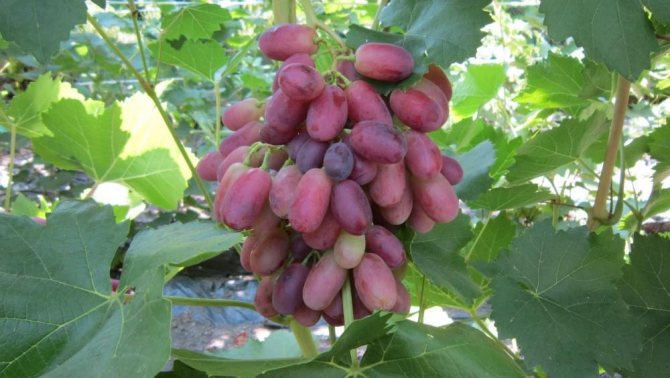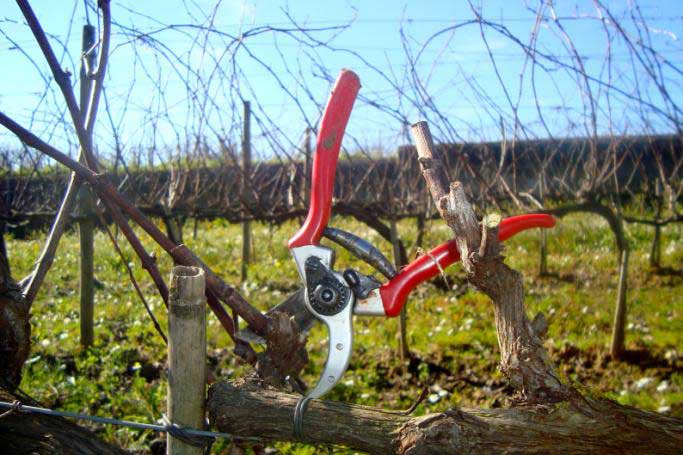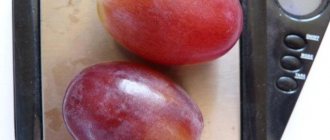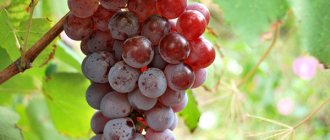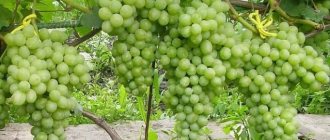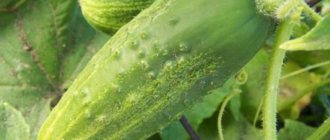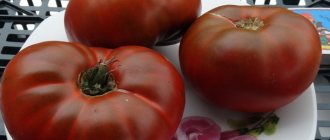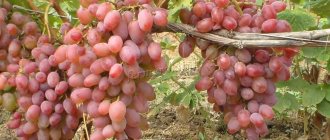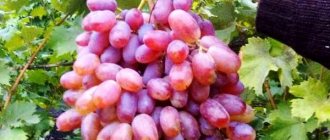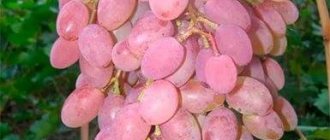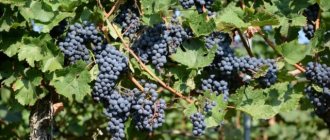Rizamat variety characteristics table
| General information about the Rizamat variety | |
| Parent couple of Vinohrada Rizamat | Katta-Kurgan x Parkent |
| The author of the variety: | Uzbekistan authors G.V. Ogienko, K.V.Smirnov, A.F. Gerasimova. |
| Main characteristics of Rizamat | |
| Purpose: | universal |
| Ripening time: | mid-early |
| Productivity: | high |
| Taste: | harmonious |
| Color: | pink |
| Frost resistance: | up to - 18 ° C |
| Description of a bunch of grapes | |
| Bunch weight: | 600-1000 gr. |
| Density of the bunch: | medium density |
| Description of grapes | |
| Berry shape: | elongated oval |
| Berry weight | 9-14 gr. |
| Diseases | |
| Disease resistance: | resistance to diseases is below average, resistance to powdery mildew is low. |
Uzbek breeders G.V. Ogienko, K.V. Smirnov, A.F. Gerasimova bred a table variety from the early ones. Rizamat grapes are a good choice for growing. This hybrid form has many advantages, more on this in the article.
Characteristic
The hybrid bush appeared as a result of the combination of the parental pair - the varieties Katta-Kurgan, Parkent. The Rizamat grape variety, which is described below, is one of the earliest fruits. It was named in memory of the famous Uzbek winegrower - Rizamat Musamukhamedov.
The bushes are vigorous, the leaves are medium in size, rounded, with five lobes. Shoots ripen in sufficient numbers, the average number of which is approximately 40-50%.
The size of the bunches is large, the shape is conical. When the brush is fully ripe, it becomes quite dense and branched. One bunch can weigh up to one kilogram. The size of the berries is large, one fruit can weigh 9-14 grams. The berries are oval, elongated, each measuring approximately 5 x 2.5 centimeters. Juicy, covered with a thin peel, which is practically not felt when consumed. The number of seeds in a berry most often does not exceed four pieces. The acidity of the fruit is on average 6 g / l, and the sugar level fluctuates around 18-23%. Abundant fertility speaks in favor of this variety. From bushes occupying one hectare of territory, you can collect up to 250 centners of fruit.
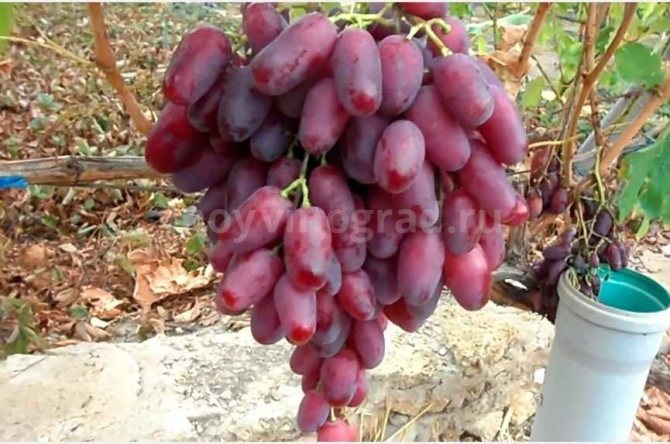
The variety can be considered versatile, suitable for fresh consumption, for making raisins. It ripens by the end of summer - at the beginning of autumn - the ripening period averages 150 days.
Many gardeners allow themselves unfounded statements that the reproduction of the Rizamat variety in their garden is the last century. Blame for everything, laziness and the desire to invest little labor in the growth of grapes, just reaping the fruits. It's hard to disagree - the variety requires a lot of attention and special care, but it's worth the effort.
The frost resistance of grapes is low, -15-18 C - in the winter cold period it needs shelter.
The appearance of the grapes
Bushes very large and require up to 10 meters of free space, however, this is offset by rich yielding properties.
Sheets medium-sized, rounded and five-fingered. Bunches conical, branched and very large (can weigh up to 3 kg). The berries themselves are large, cylindrical, weighing up to 15 g.
Color pink, the side facing the sun is usually more intense. The thickness of the skin is small and covered with a small layer of wax.However, this does not affect the taste in any way, as well as the bones, which are almost absent in the fruits.
In general, the presentable appearance and excellent taste are the great advantages of this variety.
Benefits of Rizamat
Rizamat grape is a hybrid that is quite popular among winegrowers for a reason, but due to its unique advantages:
- you can use grapes for different purposes;
- yields are always stable and high;
- outwardly, the berries are quite attractive and appetizing;
- flowers are bisexual;
- harmonious combination of acidity and sugar content;
- fully ripe berries can stay on the bushes for about two months without dropping;
- there is a demand in the market;
- easy transportation.
Doubles and descendants
The bred twins and varieties of Rizamat grapes confirm the great popularity of the fruit crop among gardeners, gardeners and farmers.
Stable
The result of the work of Ukrainian breeders. The double has nothing to do with the Rizamat variety. Of the similar characteristics, only the size of the bush is comparable.
The berry culture is not capable of independent fruiting, and the berries are white with a slight pink tint.
Ripening dates are late.
The famous three
The variety was bred by the famous breeder Krainov by crossing 3 different grape varieties.
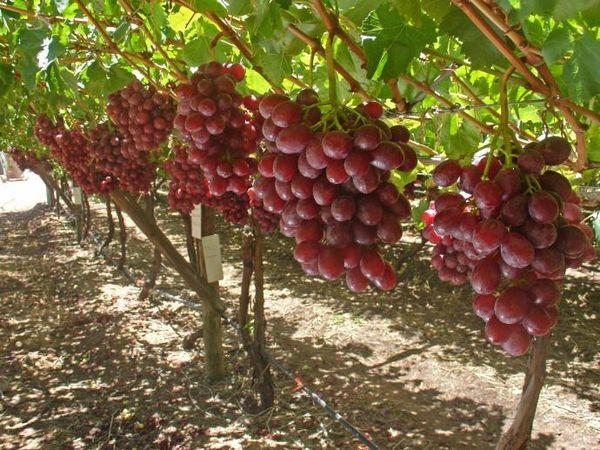

The bunches and berries are large, similar to Rizamat grapes, but the variety is absolutely independent and exists independently of the Central Asian fruit culture.
Early
The fruit of the Moldovan selection is similar in color to the Rizamat variety, but has nothing to do with it.
Descendant
In the development of the fruit crop, the Rizamat grapes and the Talisman variety were really used. The hybrid turned out to be successful, with large, tasty berries on large bunches. Initially, the new culture was named Descendant of Rizamata, but was later renamed Juliana.
Basic landing rules
Grapes are very picky about agricultural conditions, therefore, the method of planting it in the soil requires compliance with several rules:
- it is best to plant on the south side of the site - the soil must be warmed up all the time;
- the soil needs to be made nutritious, loosened for ease;
- it makes sense to plant vines on small elevations near the walls of the building, at a distance of about one meter;
- groundwater should flow at a depth of two meters below the soil;
- the seedlings that you plan to plant must be ripe and completely healthy;
- on the bottom of the pit for planting, a drainage layer, a layer of fertilizers should be laid, after which - nutritious soil;
- it is better to start planting work in the spring.
In order to control the direction of growth of the grape, it should be tied to stable vertical supports. Watering is needed for all plantings, after which the land around the bushes must be covered with a layer of mulch, preferably organic.
It is better to plant it alone - interweaving with other varieties is highly undesirable. If you decide to plant it to the rest of the grape bushes, then you need to be on the edge, at a decent distance from everyone - at least six meters.
Landing sequence
- A pit, 80x80 centimeters in size, needs to be dug two weeks before planting work;
- Pour a five-centimeter layer of rubble on the bottom, ten centimeters of fertile soil, three buckets of fertilizer, 10 centimeters of soil on top;
- Everything that is in the pit, except for rubble, must be mixed, covered with a layer of earth on top;
- The next two weeks are needed for soil subsidence;
- After 14 days, a seedling sits in the depression and is completely covered with soil;
- Creation, driving in support;
- Watering is plentiful;
- Cover the soil around the planted seedling with a layer of mulch.
Scion of a noble family
The description of the variety characterizes it as very early. Ripening period 100-105 days.The bush is tall, the bunch is large from 500 g to 1500 g and more, very beautiful, regular conical shape, up to 50 cm long. Berries weighing from 13 to 20 g, pink, even, elongated, oval, pleasant, harmonious taste with subtle nutmeg notes (when fully ripe), no peas.
Extremely fertile, amicably adjacent to rootstocks. Color from light amber to golden pink. It is characterized by an excellent presentation. High frost resistance (minus 25 - minus 26 degrees). Resistance to late blight up to 3.0 points (in unfavorable years requires preventive treatment against powdery mildew, phylloxera, gray rot). Resistance to mildew, powdery mildew and gray rot 2.0-2.5 points. Grape cuttings root well and amicably.
In regions where the temperature drops below minus 18 degrees, shelter is needed. In terms of the quality of berries, the variety is not inferior to its parents, but its resistance to diseases and low temperatures is much higher. The descendant of Rizamat was widespread and loved by amateur gardeners from Belarus, Ukraine, Russia and Moldova, the growing region has spread to the Urals, says the exchange of views on the variety at the forum.
The berries of the Descendant of Rhizomat can remain on the bushes for a long time, do not crack, do not rot and retain their taste and aroma, acquire a rich color. The variety ripens by the end of July or early August, but for better accumulation of sugar, the bunches are left to hang on the vine until the end of September, the berries acquire an amazing ruby color.
Read next: Pear Kokinskaya variety description photo reviews
Care - features
Rizamat grapes, according to the reviews on the forums, the plant is quite demanding in processing and care. With the right approach to cultivation, the owners expect high yield rates. A dangerous thing for grapes is powdery mildew, the protection against which consists in the use of colloidal sulfur.
Watering
Watering the bush should be a regular process. The amount of water depends on the soil - you need to water abundantly, but it is important not to overdo it. It is important to moisturize stably so that the plant does not feel changes in soil moisture - the berries crack from drops. It is always important to keep track of this moment, especially during the period of flowering and fruit formation.
Watering just under the bush is wrong, the water will spread. There are two ways out of the situation: dig watering holes or make depressions in the ground. All these holes should be buried after watering and mulched. Moss, sawdust that have darkened are the best options for mulch; you need to lay it out in a layer of at least three centimeters in thickness.
Top dressing
Moistening the soil should not be complete without fertilizing - it is useful for the root system, its development, nutrition of grape bushes. All necessary fertilizers need to be prepared shortly before planting. The main and most useful will be compost, wood ash and natural humus. The use of mineral fertilizers will not be superfluous - the combination of potassium with nitrogen and phosphorus will have an excellent effect on the full development of the plant.
Pruning
The Rizamat grape includes in its description the characteristics of many Central Asian varieties. The treatment of bushes also includes pruning, which is recommended for long shoots. The trim size should be about 14 eyes.
The maximum load that one bush can withstand is sixty eyes. Pruning should start in the fall, because if you get down to business in the spring, you can lose up to thirty percent of the crop.In order for the bunches to receive enough nutrition, they must be surrounded by 15 leaves. If you overdo it with circumcision, stepchildren will grow, which will negatively affect productivity.
Reproduction
It is best to propagate this variety using seedlings. Grafting Rizamat to another variety usually will not bring the expected results, and it will become more difficult for the bush to take root.
Preparing for the winter period
Due to the low tolerance of severe frosts, it is necessary to cover it warmly. If the bushes grow over the arch, you need to remove, carefully cut off the upper part, then press it to the ground and tie it to the bottom. All this should be wrapped in foil. The weather is changeable, the onset of temporary heat can end in a greenhouse effect, as a result - the damping of the vine, buds. Experienced winegrowers recommend wrapping it first in burlap, then in foil with small ventilation holes, and again in burlap.
Disease protection
Prevention of various diseases will help preserve the plant itself and the crop. To protect against fungal ailments, the bushes need to be processed three times per season. Twice before flowering, once during the formation of the grape inflorescences.
Disadvantages of this variety
All the advantages of this variety were listed above, it's time to find out about the shortcomings.
- Frosts below minus eighteen degrees will be disastrous, when growing Even in the south of our country, shelter will be necessary.
- For the rizamat, it will not be enough to cover only with film and cloth; you will need another layer of soil.
- It is rather difficult to provide such conditions.
- The variety is also susceptible to disease, especially powdery mildew or powdery mildew.
- During the fruitful season, you will have to provide about six treatments for various diseases. Of course now it won't be as difficult as it used to be.
Important! Fungicides are good at protecting grapes.

